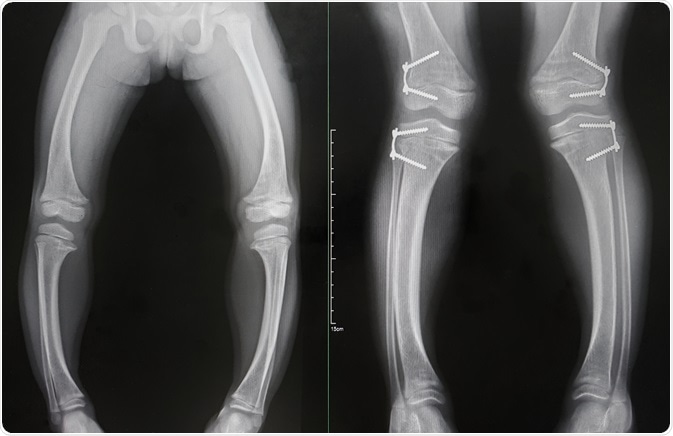Rickets is defined as a condition associated with bone-deformity due to inadequate mineralization in growing bones. Albeit some cases are caused by renal disease, use of medication or specific hereditary syndromes, nutritional insufficiency is the most common cause of rickets, particularly in the developing world.
Normal bone growth is highly dependent on adequate serum levels of vitamin D, thus insufficiency or deficiency of this vitamin is linked to the development of musculoskeletal symptoms and deformity in children – including rickets. Calcium deficiency is also thought to be the primary factor contributing to rickets in some regions of the world.
A similar condition in adults is known as osteomalacia. This disease is unjustly neglected when compared to other metabolic bone diseases and appears not to be suspected or diagnosed promptly in susceptible patients, as modern physicians are not sufficiently aware of this condition.
 Normal bones versus rickets and osteomalacia. Image Credit: Double Brain / Shutterstock.com
Normal bones versus rickets and osteomalacia. Image Credit: Double Brain / Shutterstock.com
Historical perspective
Rickets was initially reported in the mid-1600s when children who lived in polluted industrialized cities of northern Europe developed a severe bone-forming disease characterized by deformities and growth retardation. Glisson and his colleagues described typical findings of bone deformity with the curving of the legs.
In the 19th century, Sniadecki was the first to recognize the significance of sun exposure to prevent and cure rickets. This observation was extended by Palm, who promoted systemic use of sunbaths. In the early 1900s, vitamin D was found to be the essential ingredient of cod-liver oil, which was found to be effective in treating this disease.
With the introduction of vitamin D supplements, rickets became a rare diagnosis in the industrialized nations during the 20th century. Still, at the end of the last century, nutritional rickets re-emerged as an important problem in North America. It was also prevalent in economically disadvantaged parts of the world where vitamin D deficiency was not commonly found.
 Rickets. Image Credit: Bunsinth-Nan-Pua / Shutterstock.com
Rickets. Image Credit: Bunsinth-Nan-Pua / Shutterstock.com
Epidemiology
Rickets represents an important health issue not only in developing countries but also in the developed world. The prominent contributing factors include limited sunlight exposure, increased skin pigmentation, geographical location and decreased dietary intake.
The Centers for Disease Control and Prevention (CDC) estimation is that 5 of every million children between 6 months and 5 years of age have rickets, with a peak prevalence of vitamin D-deficient rickets between 6 and 18 months of age. The majority of affected children are black or breastfed.
In North America, rickets is most commonly found in children with relatively more pigmented skin, who are exclusively breastfed. In Europe and Australia, rickets is typically identified in immigrant populations from the Indian subcontinent and the Middle East.
In the United States, nutritional rickets was eradicated in the 1930s after discovering that vitamin D possessed antirachitic properties. However, the disease has made an unfortunate comeback, primarily due to a lack of appreciation that human milk contains very little vitamin D to satisfy the infant’s requirement.
Of the genetic causes, X-linked hypophosphatemic rickets is most commonly encountered, with a prevalence of 1 in 20 thousand children. Other genetic causes (such as autosomal dominant and autosomal recessive, or mutations in vitamin D 25-hydroxylase or 1-alpha-hydroxylase enzymes) are exceptionally rare.
What is Rickets/Osteomalacia?!
References
Further Reading